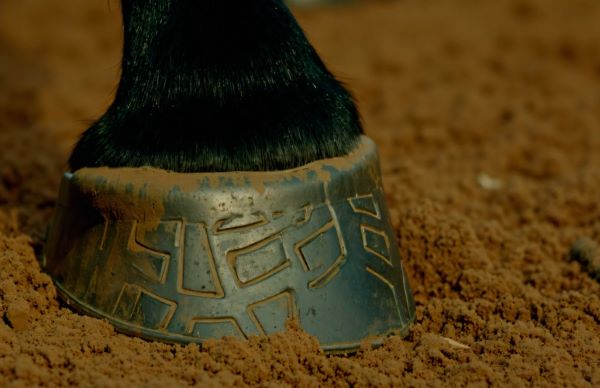Hoof Flaring: the perils of White Line Separation
Picture your horse’s white line as a strong piece of Velcro, bonding the hoof wall to the coffin bone. If the hoof wall grows too long, it will start to push outwards, away from the internal structure.
This separation of the white line from the hoof wall is called ‘Flaring’. And you won’t be surprised that the condition is notorious amongst transitioning horses. Their white line is weak and stretchy as it recovers from the time spent wearing shoes.
You must always check for flare before each trim, along with any splits and bulges further up the hoof. If you don’t, you can end up with all kinds of trouble.
First of all, flare is painful for the horse (imagine that pressure on your fingernail). It leaves an opening for bacteria, it causes bulges to form, and if untreated can deteriorate into mechanical founder. This is when the hoof wall completely detaches from the coffin bone, resulting in severe lameness.
So what should you do if your horse’s hooves are flared?
Fighting flare
- Trim any flaring of the hoof wall to an even thickness around the white line.
- Apply a mustang roll around the hoof. A smooth roll on the hooves stops the flare acting as a lever, prizing the hoof wall away from the coffin bone. Renew this weekly.
Barefoot trimmer Sarah Bell says most flare is addressed in these steps alone.
But you may also …
- Apply the mustang roll further back than you would on a sound hoof. Pete Ramey’s “White Line Strategy” involves bringing the roll all the way back to the edge of the forward growing sole. Once the flare has disappeared, bring the mustang roll back to the water line.
- Give your horse plenty of exercise. Stimulating growth of new hoof material is the fastest way to bring back a strong white line.
- Marjorie Smith recommends having the horse turned out 24 hours a day. If you can’t manage this, keep the horse out as long as possible. As she says, “I have seen feet that were doing well during daytime turnout, become sore overnight in a stall.”
Please remember to only trim the bottom of the hoof wall. You must be patient with bulges that run higher. Your horse must grow the problem out. Never rasp down the length of the hoof wall. Instead, adopt a regular, weekly trimming routine – ‘little and often’.
If you’re unsure of what you’re doing always get help from somone experienced in hoof trimming.
During treatment for flare, your horse may appear uncomfortable. The change often has it ‘walking on the soles’. But this isn’t nearly as unpleasant as the pain of white line separation – especially if you use sole pads to help during the recovery.
And now onto Tommy.

Hoof Flaring: What It Is and How to Tackle It
“Let’s talk about hoof flaring—you know, when your horse’s hooves start to look a little, well, wonky. Hoof flaring happens when the hoof wall spreads or bulges outward, giving it a flared shape (hence the name!). Not only can it look off, but it can also lead to cracking, chipping, or even discomfort for your horse.”
“So, what causes hoof flaring? A big culprit is imbalance. If the hoof isn’t trimmed properly or grows unevenly, extra pressure can push the wall outward. Another common cause is a poor diet. Weak hooves and hoof flaring often go hand in hand when the horse isn’t getting the nutrients they need for strong, healthy hoof growth.”
“Now, how do we fix it? First, call your farrier! Regular trims are your best defense against hoof flaring. A skilled farrier will balance the hoof and remove the excess growth to get things back in shape. Don’t skip appointments—waiting too long between trims is one of the main reasons hoof flaring happens in the first place.”
“Next, take a look at your horse’s living conditions. Wet or muddy environments can weaken the hoof wall and make flaring worse. Try to keep your horse’s turnout area as dry and clean as possible.”
“And, of course, we can’t forget diet! A balanced diet rich in biotin, zinc, and amino acids can help strengthen the hoof and prevent future flaring. Supplements designed for hoof health are a great option if your horse needs an extra boost.”
“Hoof flaring isn’t the end of the world, but it’s definitely something to address quickly. With the right farrier care, management, and nutrition, your horse’s hooves can get back to their natural, healthy shape in no time! Tommy”
Next up
Please put your knife away !!!! You cut the callus ridge which the major support of the hoof…you also trimmed the walls too short, try leaving a 1/16th of an inch everywhere but at the quarters next time. Your trim is the major reason that HORSE IS SO FLAT SOLED.
I am afraid bruce mcneill could be right–put your knife away..